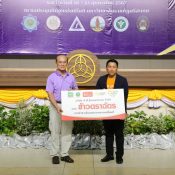
Things to know before planting maize
According to the Agricultural Economics Office for the year 2018/2019, Thailand has approximately 6.76 million Rai of land dedicated to maize cultivation with a total production ranging between 4.5 to 5 million tons per year. However, Thailand's demand for maize is estimated around 8 million tons annually. The majority of the maize produced is used as animal feed, such as for poultry, swine and pig. Maize cultivation in Thailand is divided into 3 seasons: early rainy season (72%), late rainy season (23%), and dry season or after rice (5%). The most crucial factor in achieving high maize yields is for farmers to understand the conditions of their cultivation plots and the soil types. This knowledge allows them to select suitable seed and employ appropriate cultivation practices. Maize cultivation areas in Thailand can be categorized into 4 groups.
- The river basin areas refer to lands situated along rivers, streams, canals, marshes, and reservoirs, which are prone to flooding during the rainy season. Therefore, it's necessary to plant and harvest maize before the flooding occurs or cultivate it after the water recedes. The soil in these areas is typically fertile. Most of these areas are located in the lower northern and upper northern regions of Thailand.
- The flat areas refer to lands that are relatively flat and predominantly consist of loamy to sandy loam soil types. These soils have good drainage and are moderately to highly fertile, making them highly suitable for maize cultivation. Maize cultivation in these areas primarily relies on rainfall and is commonly found in central, lower northern, and some parts of the northeastern regions of Thailand.
- The slope areas are characterized by sloping terrain with good drainage. However, erosion and soil degradation may occur due to the slope, leading to sandy soil and lower fertility. These areas are commonly found in the upper northern and some parts of the northeastern regions of Thailand.
- The rice fields are low-lying areas characterized by various soil types including sandy, loamy, and clayey soils. Maize cultivation in rice fields requires proper water management to ensure good drainage. It can be practiced in the northeastern, central, and lower northern regions of Thailand. Besides understanding the terrain of the maize cultivation areas, it's crucial to know the soil type—whether it's sandy, loamy, or clayey. This knowledge informs the management practices, fertilizer application, and growth of maize, as they vary depending on the soil type.




